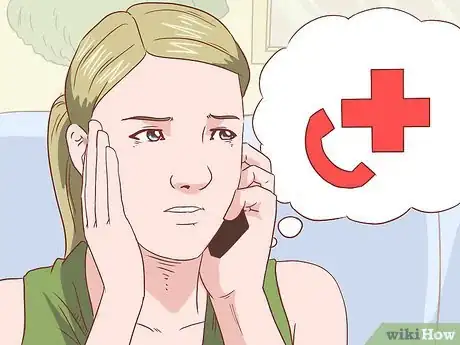This article was co-authored by Hilya Tehrani, PsyD. Dr. Hilya Tehrani is a Licensed Clinical Psychologist with over twenty years of experience. She specializes in working with children and adolescents. Dr. Tehrani also has expertise in supporting individuals with autism, ADHD, anxiety, behavioral challenges, and learning and processing differences. She holds a BA in Psychology from The University of California, Los Angeles, an MA in Clinical Psychology from California State University, Northridge, and a PsyD in Clinical Psychology from Pepperdine University.
There are 7 references cited in this article, which can be found at the bottom of the page.
wikiHow marks an article as reader-approved once it receives enough positive feedback. This article received 11 testimonials and 99% of readers who voted found it helpful, earning it our reader-approved status.
This article has been viewed 339,213 times.
Autistic people can get overwhelmed by sensory input or strong emotions. When this happens, they often need someone to gently escort them to a quiet place so they can calm down. Here are some ways you can help an autistic person in distress.
Steps
Taking the First Steps
-
1Take a moment to calm yourself. If you can keep a calm demeanor, you'll help the autistic person feel calmer too.[1]
- Keep a patient and understanding attitude. Show them the same kindness that you'd want other people to show you if you were at your wits' end.
- Never shout at, scold, or punish an autistic person for being upset. They aren't doing this on purpose, and being unkind will only make it worse. If you can't control yourself, it's better to leave than to make the situation worse.
-
2Ask what's wrong, if the person is able to speak. Sometimes, they may be overwhelmed, and need quiet time. Other times, they might be experiencing difficult emotions related to something in their life (like a bad grade at school or an argument with a friend).
- During severe sensory overload, people who are ordinarily verbal may suddenly lose the ability to speak. This is due to severe overstimulation and will pass with relaxation time. If someone has lost the ability to speak, ask only yes/no questions that they can answer with thumbs up/thumbs down.
Advertisement -
3
-
4Ask if they want you to stay with them. Sometimes, the person might want you there to keep them company and help them calm down. Other times, they might want to be alone for a while. Either way, don't take it personally.
- If they can't speak right now, let them answer with a thumbs up/thumbs down. Or you can say "Do you want me to stay or leave?" and point at the ground and at the door, and then let them point to where they want you to be.
- If a small child wants to be left alone, you can sit across the room and do something quiet (like playing on your phone or reading a book) so there is still an adult present.[4]
-
5Help them with any difficult tasks. When they're distressed, they may be unable to think clearly, and they may have trouble doing simple tasks like taking off an uncomfortable sweater or getting a drink of water. Help them out, without infringing on their personal space.
- If they're tugging at uncomfortable clothing, offer to help them remove it.[5] (Don't try to remove clothes without permission, as this can be startling and upsetting.)
- If they're trying to drink from the sink, get a cup for them.
-
6Keep them safe if they are thrashing, flailing, or throwing things. Move dangerous or breakable objects out of their way. Put a pillow or folded-up jacket under their head to protect it, or put their head on your lap if it's safe.
- If they are throwing things, it might be that the throwing motion calms them down. Try giving them something that can be thrown safely (like a throw pillow). Let them throw it, and then retrieve it so they can throw it again. This can calm them.
- If you don't feel safe getting close to them, then don't. Let them continue until they calm down and wear themselves out.
-
7Get help if you don't know what to do. Parents, teachers, and caregivers may know how to help. They may be able to offer specific insight about the autistic person's particular needs.
- Police are not usually trained to help with autistic meltdowns, and they may worsen the situation or hurt your autistic loved one. Instead, get someone who the autistic person knows and trusts.
Using Sensory Calming Techniques
-
1Reduce sensory input to help an overwhelmed autistic person. Often, autistic people have problems with sensory input; they hear, feel, and see things much more intensely than others do. It is as if the volume for everything has been turned up.[6]
- Turn off distracting devices like TVs or radios (unless the autistic person tells you that they want it on).
- Try dimming the lights.
- Let them hide in small places if they want. For example, if they want to hide in a closet or shut themselves into a cupboard with their phone, let them. (Just make sure that they can get out on their own.)
-
2Touch them only if they are okay with it. Hold them, rub their shoulders, and show affection. Use firm touch, instead of light touch, because this is more reassuring. It could help them calm down. If they say or show they don't want to be touched, don't take it personally; they simply can't handle touch at the moment.[7]
- You can offer a hug by spreading your arms and seeing if they come to you.
- If you hug them, and they stiffen or push away, let them go. Maybe they aren't able to handle the sensory input of hugging right now, or maybe your clothes have a texture that's uncomfortable to them.[8]
-
3Try massaging an autistic person who wants to be touched. Many autistic people have benefited from massage therapy. Help them into a comfortable position, gently squeeze their temples, massage their shoulders, rub their backs, or their feet. Keep your movements gentle, soothing, and careful.[9]
- They may direct you to areas that they want you to touch, such as by pointing at their shoulders or squeezing their face.
-
4Let them stim safely as much as they need to. Stimming is a series of repetitive movements that are calming mechanisms for autistic people. Examples of stimming include hand flapping, finger flicking, and rocking. Stimming is a crucial self-calming mechanism during emotional distress.
- If they are hurting themselves, see if you can redirect them to doing something safer (like hitting couch cushions instead of their head).
- Don't restrain them, no matter what they are doing.[10] Grabbing and holding an autistic person against their will is dangerous, especially when the person is in fight-or-flight mode. Both of you could get seriously hurt during the autistic person's attempts to break free.
-
5Offer to apply gentle pressure to their body. If the person is sitting up, stand behind them and cross your arms over their chest. Face your head sideways and rest your cheek on them head. Squeeze them tightly, asking them if they want you to squeeze less or more tightly. This is called deep pressure, and it should help them relax and feel better.[11]
- Alternatively give the person a weighted blanket to use for calming deep pressure.[12]
Using Verbal Techniques
-
1Ask if they'd like you to lead them in a relaxation exercise. If the cause of distress seems to be emotional (not sensory), then a relaxation exercise may help them calm down enough to talk about it. If they say yes to a relaxation exercise, try helping them through one of these:
- Sensory grounding: Have them name 5 things they can see right now, 4 things they can touch, 3 things they can hear, 2 things they can smell (or that they like to smell in general), and 1 good thing about themselves. Count off on your fingers.
- Box breathing: Have them breathe in for a count of 4, hold it for a count of 4, breathe out for a count of 4, rest for a count of 4, and repeat.
-
2Listen and validate their feelings if they want to talk about what's bothering them. Sometimes, people just need to vent and be listened to. Let them talk it out if they want to discuss what's bothering them. Here are some helpful examples of things you could say:
- "I'm here to listen if you'd like to talk about it."
- "Take your time. I'm not going anywhere."
- "I'm sorry to hear that that happened to you."
- "That sounds difficult."
- "Of course you're upset. You're in a really tough situation. It's natural to be stressed about that."
-
3Let them cry it out. Sometimes, people just need to "have a good cry" and let out their emotions.
- Try saying "It's okay to cry" or "Cry all you need to. I'm here."
-
4Offer comfort as needed. You can bring a comfort item, offer to play their favorite music, offer affection, or do whatever you know helps the autistic person feel calmer.
- What's most calming can be different depending on the situation. So if they decline a hug in favor of listening to their favorite music and rocking back and forth, don't take it personally. They know what they need right now.
Expert Q&A
-
QuestionDo trampolines help children with autism?
 Hilya Tehrani, PsyDDr. Hilya Tehrani is a Licensed Clinical Psychologist with over twenty years of experience. She specializes in working with children and adolescents. Dr. Tehrani also has expertise in supporting individuals with autism, ADHD, anxiety, behavioral challenges, and learning and processing differences. She holds a BA in Psychology from The University of California, Los Angeles, an MA in Clinical Psychology from California State University, Northridge, and a PsyD in Clinical Psychology from Pepperdine University.
Hilya Tehrani, PsyDDr. Hilya Tehrani is a Licensed Clinical Psychologist with over twenty years of experience. She specializes in working with children and adolescents. Dr. Tehrani also has expertise in supporting individuals with autism, ADHD, anxiety, behavioral challenges, and learning and processing differences. She holds a BA in Psychology from The University of California, Los Angeles, an MA in Clinical Psychology from California State University, Northridge, and a PsyD in Clinical Psychology from Pepperdine University.
Licensed Clinical Psychologist For some people, yes! Some children like the different sensory input that trampolines offer. If a child tends to like jumping off furniture or other surfaces, a trampoline might help them in times of stress or dysregulation.
For some people, yes! Some children like the different sensory input that trampolines offer. If a child tends to like jumping off furniture or other surfaces, a trampoline might help them in times of stress or dysregulation.
Warnings
- Meltdowns/breakdowns are never a ploy for attention. Do not treat it as a simple temper tantrum. They are extremely difficult to control, and often result in the autistic person feeling embarrassed or remorseful.⧼thumbs_response⧽
- Never leave the person on their own unless you are in a safe and familiar environment.⧼thumbs_response⧽
- Never hit the person.⧼thumbs_response⧽
- Do not ever shout at the person. Remember, they are autistic, so this may be the only way they can express discomfort.⧼thumbs_response⧽
- Do not scold the person for having a meltdown. While the person most likely knows that public breakdowns are not acceptable, a meltdown is often the snapping point of accumulating stress and cannot be controlled.
- Don't say things like "that's crazy" or "you look mentally retarded". That can undermine their self-esteem and make you look ignorant.
⧼thumbs_response⧽
References
- ↑ https://www.autism.org.uk/advice-and-guidance/topics/behaviour/meltdowns/all-audiences
- ↑ Hilya Tehrani, PsyD. Licensed Clinical Psychologist. Expert Interview. 27 August 2021.
- ↑ https://www.autism.org.uk/advice-and-guidance/topics/behaviour/meltdowns/all-audiences
- ↑ https://www.autism.org.uk/advice-and-guidance/topics/behaviour/meltdowns/all-audiences
- ↑ https://www.autismparentingmagazine.com/tame-tantrums-manage-meltdowns/
- ↑ Hilya Tehrani, PsyD. Licensed Clinical Psychologist. Expert Interview. 27 August 2021.
- ↑ https://www.autismparentingmagazine.com/tame-tantrums-manage-meltdowns/
- ↑ https://autismawarenesscentre.com/does-my-child-have-sensory-processing-disorder/
- ↑ https://www.autismparentingmagazine.com/how-autism-qi-gong-massage-helped-my-daughter/
- ↑ https://childmind.org/article/autism-and-stimming/
- ↑ https://www.appliedbehavioranalysisedu.org/what-is-deep-pressure-stimulation/
- ↑ Hilya Tehrani, PsyD. Licensed Clinical Psychologist. Expert Interview. 27 August 2021.
- ↑ https://www.autism.org.uk/advice-and-guidance/topics/behaviour/meltdowns/all-audiences
- ↑ https://www.autism.org.uk/advice-and-guidance/topics/behaviour/meltdowns/all-audiences
- ↑ https://www.autism.org.uk/advice-and-guidance/topics/behaviour/meltdowns/all-audiences
About This Article
Autistic people can become overwhelmed by sensory input or strong emotions, but you can help calm them down with a few simple techniques. Start by taking a moment to calm yourself so you can be patient and kind during the interaction. Try taking the person to a quiet spot or ask those around you to be quiet to help create a less stimulating atmosphere. When possible, turn off distractions like TVs or radios and try dimming the lights. If the person is able to speak, ask them what’s wrong. You can also use yes or no questions that they can respond to with a thumbs up or down. A key question you’ll want to ask is if they want you there to help or if they’d rather be left alone for a while. If they want you to stay with them, offer to lead them through a relaxation exercise, like having them name 5 things they can see right now, 4 things they can touch, 3 things they can hear, 2 things they can smell, and 1 thing they think is good. To learn how to keep an autistic person safe while they’re upset, keep reading.








-Step-11.webp)







































































Medical Disclaimer
The content of this article is not intended to be a substitute for professional medical advice, examination, diagnosis, or treatment. You should always contact your doctor or other qualified healthcare professional before starting, changing, or stopping any kind of health treatment.
Read More...